Systems Analysis and Design Report: COIT 20248, Term 2, 2018
VerifiedAdded on 2019/10/09
|13
|2173
|320
Report
AI Summary
This report, prepared for COIT 20248: Information Systems Analysis and Design, details the development of an Enterprise Resource Planning (ERP) system for the International Charity Foundation (ICF). The report outlines the need for an automated system to replace manual processes, proposing a waterfall approach with project management for system development. It specifies functional requirements such as online enrollment, donation processing, inventory management, and financial tracking, alongside non-functional requirements. A cost-benefit analysis indicates a breakeven point in three years, with a detailed work breakdown structure and Gantt chart presented for project scheduling. The report also discusses system information requirement investigation techniques like document analysis, requirements workshops, and brainstorming. The analysis emphasizes the importance of a well-defined approach, requirements gathering, and cost-benefit assessment for successful ERP implementation, ultimately aiming to enhance efficiency and reduce operational costs for ICF.
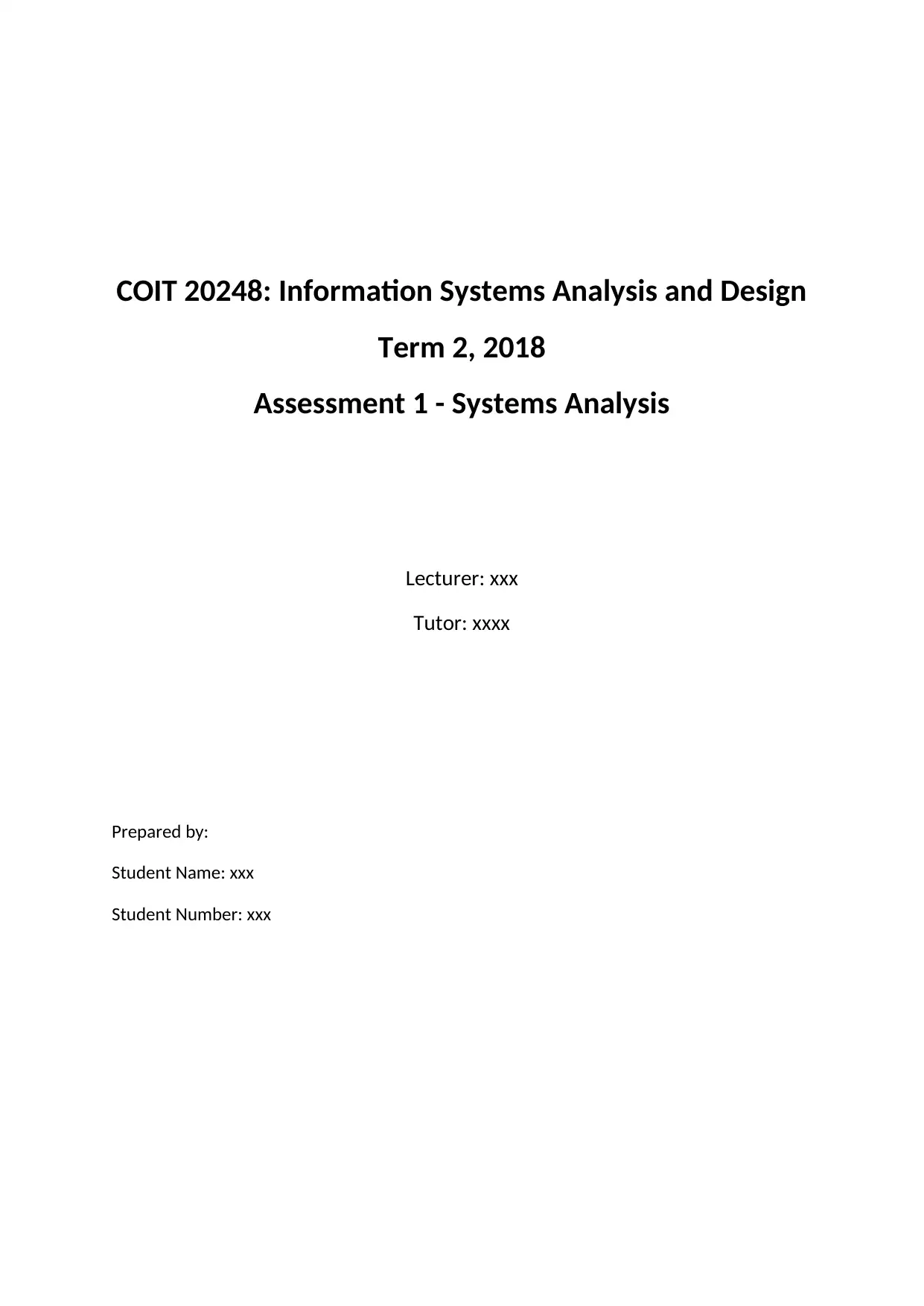
COIT 20248: Information Systems Analysis and Design
Term 2, 2018
Assessment 1 - Systems Analysis
Lecturer: xxx
Tutor: xxxx
Prepared by:
Student Name: xxx
Student Number: xxx
Term 2, 2018
Assessment 1 - Systems Analysis
Lecturer: xxx
Tutor: xxxx
Prepared by:
Student Name: xxx
Student Number: xxx
Paraphrase This Document
Need a fresh take? Get an instant paraphrase of this document with our AI Paraphraser

Table of Contents
1. Introduction.......................................................................................................................................1
2. Approach to Systems Development..................................................................................................2
3. Systems Requirements......................................................................................................................3
4. Project Cost and Benefit Analysis......................................................................................................4
6. System Information Requirement Investigation Techniques.............................................................9
7. Reflections and Conclusions............................................................................................................10
REFERENCES:.......................................................................................................................................11
1. Introduction.......................................................................................................................................1
2. Approach to Systems Development..................................................................................................2
3. Systems Requirements......................................................................................................................3
4. Project Cost and Benefit Analysis......................................................................................................4
6. System Information Requirement Investigation Techniques.............................................................9
7. Reflections and Conclusions............................................................................................................10
REFERENCES:.......................................................................................................................................11
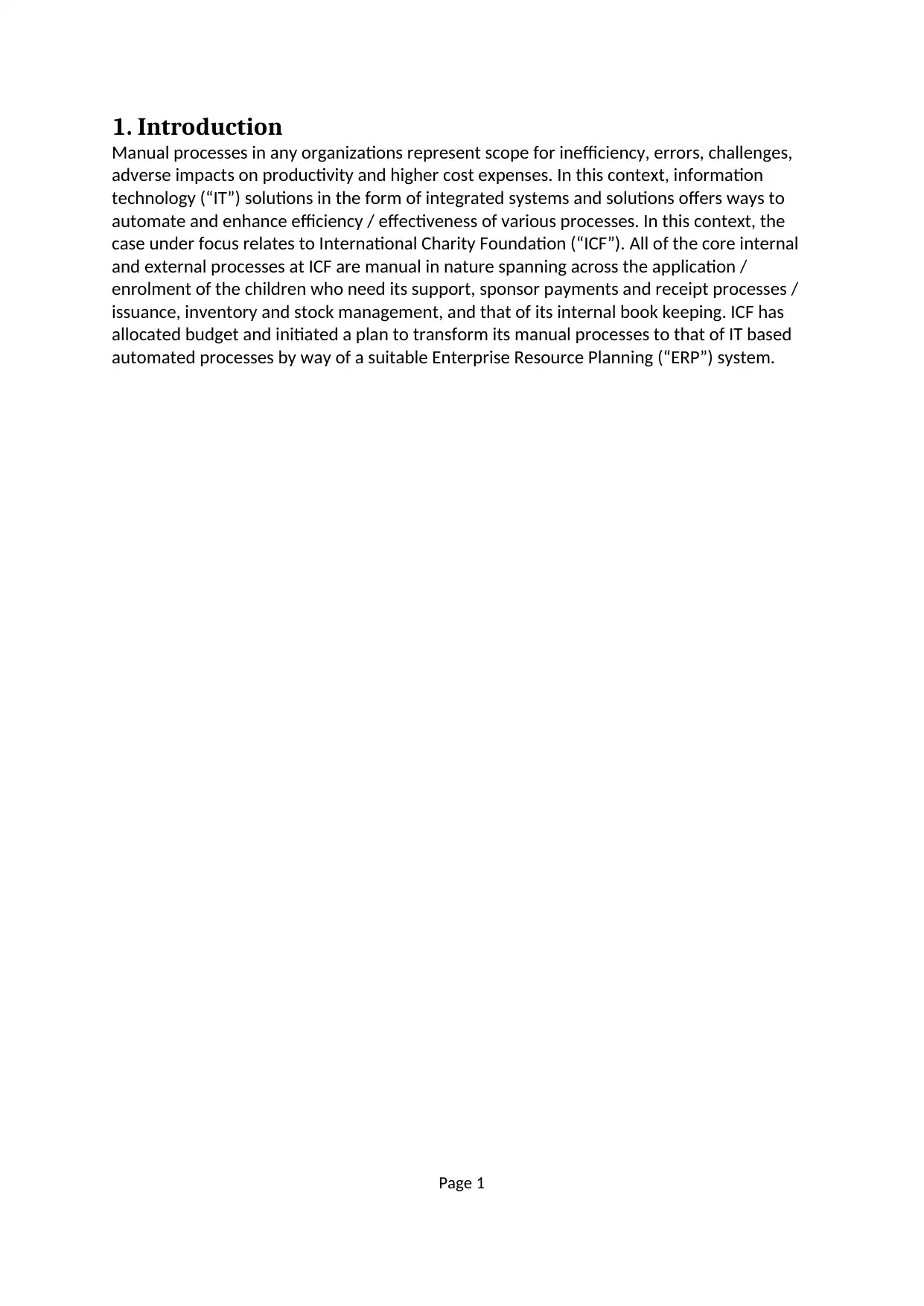
1. Introduction
Manual processes in any organizations represent scope for inefficiency, errors, challenges,
adverse impacts on productivity and higher cost expenses. In this context, information
technology (“IT”) solutions in the form of integrated systems and solutions offers ways to
automate and enhance efficiency / effectiveness of various processes. In this context, the
case under focus relates to International Charity Foundation (“ICF”). All of the core internal
and external processes at ICF are manual in nature spanning across the application /
enrolment of the children who need its support, sponsor payments and receipt processes /
issuance, inventory and stock management, and that of its internal book keeping. ICF has
allocated budget and initiated a plan to transform its manual processes to that of IT based
automated processes by way of a suitable Enterprise Resource Planning (“ERP”) system.
Page 1
Manual processes in any organizations represent scope for inefficiency, errors, challenges,
adverse impacts on productivity and higher cost expenses. In this context, information
technology (“IT”) solutions in the form of integrated systems and solutions offers ways to
automate and enhance efficiency / effectiveness of various processes. In this context, the
case under focus relates to International Charity Foundation (“ICF”). All of the core internal
and external processes at ICF are manual in nature spanning across the application /
enrolment of the children who need its support, sponsor payments and receipt processes /
issuance, inventory and stock management, and that of its internal book keeping. ICF has
allocated budget and initiated a plan to transform its manual processes to that of IT based
automated processes by way of a suitable Enterprise Resource Planning (“ERP”) system.
Page 1
⊘ This is a preview!⊘
Do you want full access?
Subscribe today to unlock all pages.

Trusted by 1+ million students worldwide
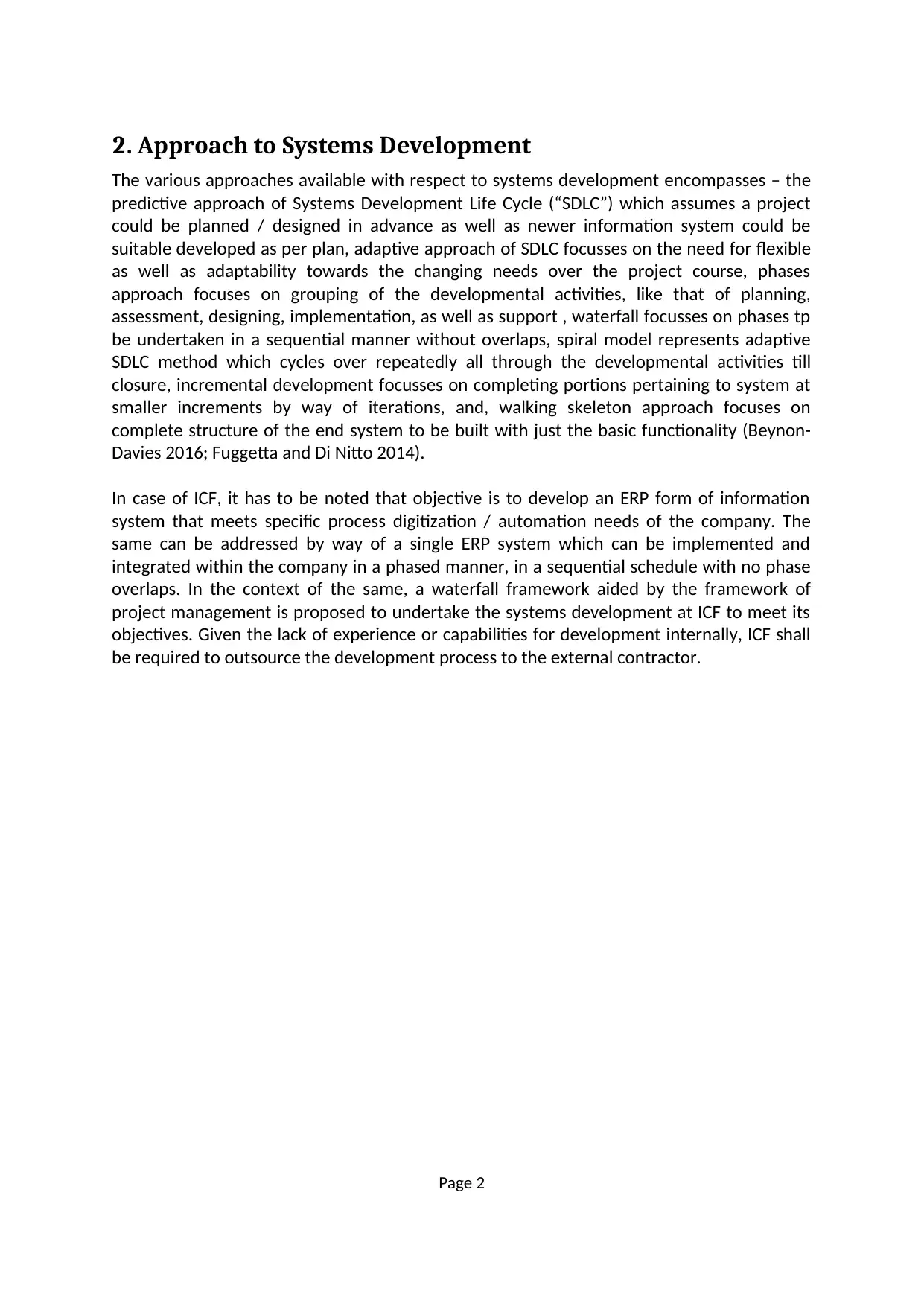
2. Approach to Systems Development
The various approaches available with respect to systems development encompasses – the
predictive approach of Systems Development Life Cycle (“SDLC”) which assumes a project
could be planned / designed in advance as well as newer information system could be
suitable developed as per plan, adaptive approach of SDLC focusses on the need for flexible
as well as adaptability towards the changing needs over the project course, phases
approach focuses on grouping of the developmental activities, like that of planning,
assessment, designing, implementation, as well as support , waterfall focusses on phases tp
be undertaken in a sequential manner without overlaps, spiral model represents adaptive
SDLC method which cycles over repeatedly all through the developmental activities till
closure, incremental development focusses on completing portions pertaining to system at
smaller increments by way of iterations, and, walking skeleton approach focuses on
complete structure of the end system to be built with just the basic functionality (Beynon-
Davies 2016; Fuggetta and Di Nitto 2014).
In case of ICF, it has to be noted that objective is to develop an ERP form of information
system that meets specific process digitization / automation needs of the company. The
same can be addressed by way of a single ERP system which can be implemented and
integrated within the company in a phased manner, in a sequential schedule with no phase
overlaps. In the context of the same, a waterfall framework aided by the framework of
project management is proposed to undertake the systems development at ICF to meet its
objectives. Given the lack of experience or capabilities for development internally, ICF shall
be required to outsource the development process to the external contractor.
Page 2
The various approaches available with respect to systems development encompasses – the
predictive approach of Systems Development Life Cycle (“SDLC”) which assumes a project
could be planned / designed in advance as well as newer information system could be
suitable developed as per plan, adaptive approach of SDLC focusses on the need for flexible
as well as adaptability towards the changing needs over the project course, phases
approach focuses on grouping of the developmental activities, like that of planning,
assessment, designing, implementation, as well as support , waterfall focusses on phases tp
be undertaken in a sequential manner without overlaps, spiral model represents adaptive
SDLC method which cycles over repeatedly all through the developmental activities till
closure, incremental development focusses on completing portions pertaining to system at
smaller increments by way of iterations, and, walking skeleton approach focuses on
complete structure of the end system to be built with just the basic functionality (Beynon-
Davies 2016; Fuggetta and Di Nitto 2014).
In case of ICF, it has to be noted that objective is to develop an ERP form of information
system that meets specific process digitization / automation needs of the company. The
same can be addressed by way of a single ERP system which can be implemented and
integrated within the company in a phased manner, in a sequential schedule with no phase
overlaps. In the context of the same, a waterfall framework aided by the framework of
project management is proposed to undertake the systems development at ICF to meet its
objectives. Given the lack of experience or capabilities for development internally, ICF shall
be required to outsource the development process to the external contractor.
Page 2
Paraphrase This Document
Need a fresh take? Get an instant paraphrase of this document with our AI Paraphraser
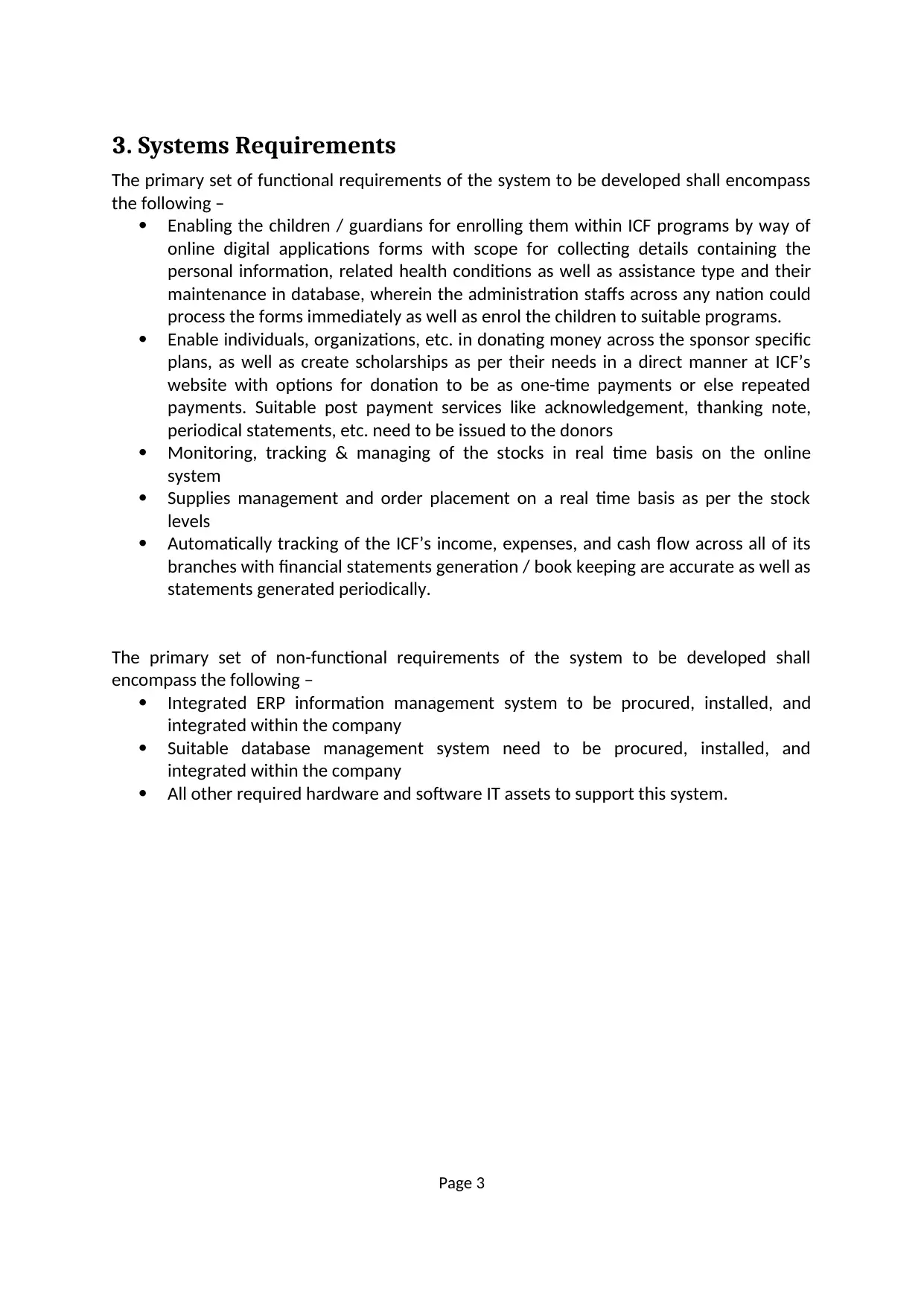
3. Systems Requirements
The primary set of functional requirements of the system to be developed shall encompass
the following –
Enabling the children / guardians for enrolling them within ICF programs by way of
online digital applications forms with scope for collecting details containing the
personal information, related health conditions as well as assistance type and their
maintenance in database, wherein the administration staffs across any nation could
process the forms immediately as well as enrol the children to suitable programs.
Enable individuals, organizations, etc. in donating money across the sponsor specific
plans, as well as create scholarships as per their needs in a direct manner at ICF’s
website with options for donation to be as one-time payments or else repeated
payments. Suitable post payment services like acknowledgement, thanking note,
periodical statements, etc. need to be issued to the donors
Monitoring, tracking & managing of the stocks in real time basis on the online
system
Supplies management and order placement on a real time basis as per the stock
levels
Automatically tracking of the ICF’s income, expenses, and cash flow across all of its
branches with financial statements generation / book keeping are accurate as well as
statements generated periodically.
The primary set of non-functional requirements of the system to be developed shall
encompass the following –
Integrated ERP information management system to be procured, installed, and
integrated within the company
Suitable database management system need to be procured, installed, and
integrated within the company
All other required hardware and software IT assets to support this system.
Page 3
The primary set of functional requirements of the system to be developed shall encompass
the following –
Enabling the children / guardians for enrolling them within ICF programs by way of
online digital applications forms with scope for collecting details containing the
personal information, related health conditions as well as assistance type and their
maintenance in database, wherein the administration staffs across any nation could
process the forms immediately as well as enrol the children to suitable programs.
Enable individuals, organizations, etc. in donating money across the sponsor specific
plans, as well as create scholarships as per their needs in a direct manner at ICF’s
website with options for donation to be as one-time payments or else repeated
payments. Suitable post payment services like acknowledgement, thanking note,
periodical statements, etc. need to be issued to the donors
Monitoring, tracking & managing of the stocks in real time basis on the online
system
Supplies management and order placement on a real time basis as per the stock
levels
Automatically tracking of the ICF’s income, expenses, and cash flow across all of its
branches with financial statements generation / book keeping are accurate as well as
statements generated periodically.
The primary set of non-functional requirements of the system to be developed shall
encompass the following –
Integrated ERP information management system to be procured, installed, and
integrated within the company
Suitable database management system need to be procured, installed, and
integrated within the company
All other required hardware and software IT assets to support this system.
Page 3
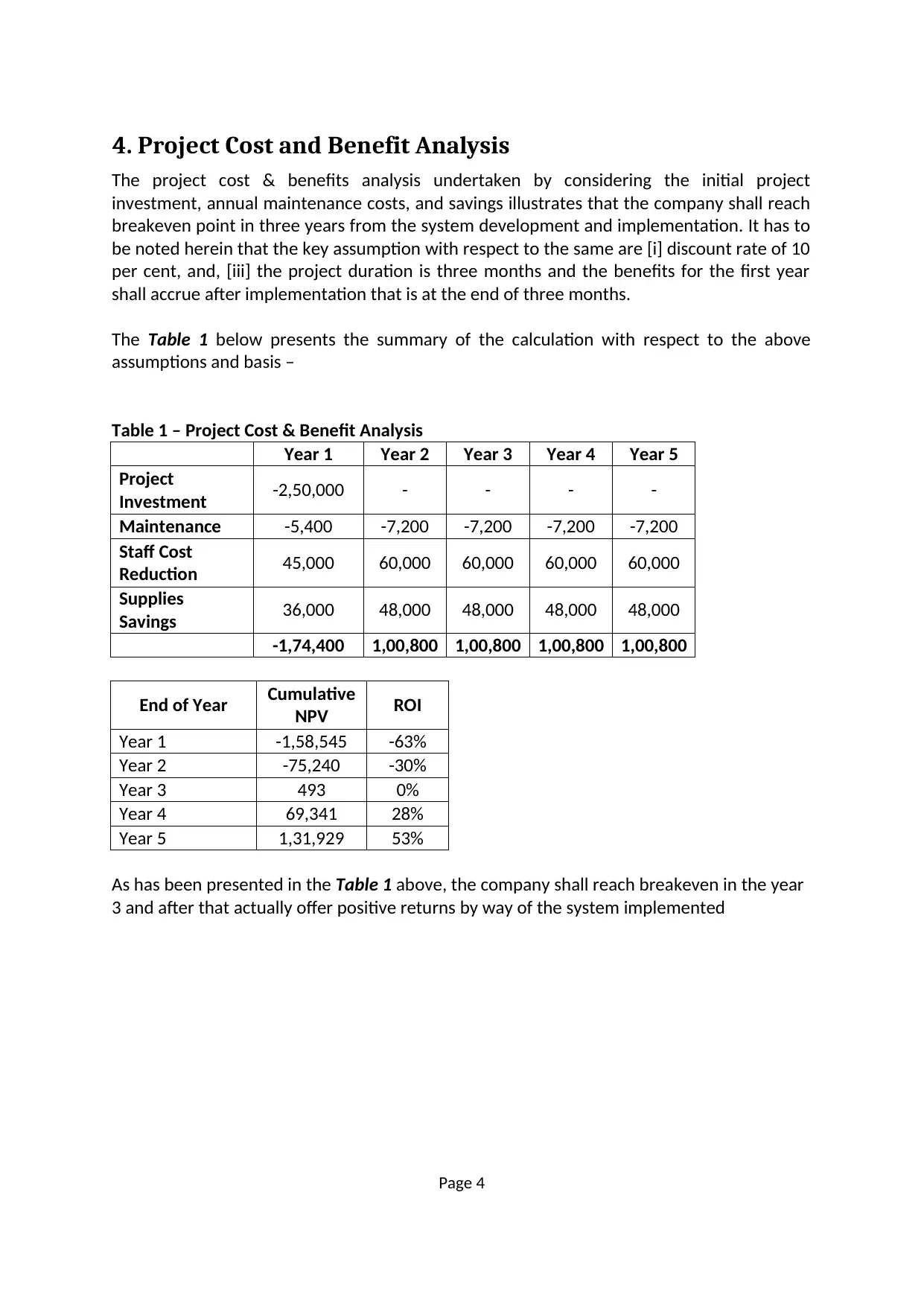
4. Project Cost and Benefit Analysis
The project cost & benefits analysis undertaken by considering the initial project
investment, annual maintenance costs, and savings illustrates that the company shall reach
breakeven point in three years from the system development and implementation. It has to
be noted herein that the key assumption with respect to the same are [i] discount rate of 10
per cent, and, [iii] the project duration is three months and the benefits for the first year
shall accrue after implementation that is at the end of three months.
The Table 1 below presents the summary of the calculation with respect to the above
assumptions and basis –
Table 1 – Project Cost & Benefit Analysis
Year 1 Year 2 Year 3 Year 4 Year 5
Project
Investment -2,50,000 - - - -
Maintenance -5,400 -7,200 -7,200 -7,200 -7,200
Staff Cost
Reduction 45,000 60,000 60,000 60,000 60,000
Supplies
Savings 36,000 48,000 48,000 48,000 48,000
-1,74,400 1,00,800 1,00,800 1,00,800 1,00,800
End of Year Cumulative
NPV ROI
Year 1 -1,58,545 -63%
Year 2 -75,240 -30%
Year 3 493 0%
Year 4 69,341 28%
Year 5 1,31,929 53%
As has been presented in the Table 1 above, the company shall reach breakeven in the year
3 and after that actually offer positive returns by way of the system implemented
Page 4
The project cost & benefits analysis undertaken by considering the initial project
investment, annual maintenance costs, and savings illustrates that the company shall reach
breakeven point in three years from the system development and implementation. It has to
be noted herein that the key assumption with respect to the same are [i] discount rate of 10
per cent, and, [iii] the project duration is three months and the benefits for the first year
shall accrue after implementation that is at the end of three months.
The Table 1 below presents the summary of the calculation with respect to the above
assumptions and basis –
Table 1 – Project Cost & Benefit Analysis
Year 1 Year 2 Year 3 Year 4 Year 5
Project
Investment -2,50,000 - - - -
Maintenance -5,400 -7,200 -7,200 -7,200 -7,200
Staff Cost
Reduction 45,000 60,000 60,000 60,000 60,000
Supplies
Savings 36,000 48,000 48,000 48,000 48,000
-1,74,400 1,00,800 1,00,800 1,00,800 1,00,800
End of Year Cumulative
NPV ROI
Year 1 -1,58,545 -63%
Year 2 -75,240 -30%
Year 3 493 0%
Year 4 69,341 28%
Year 5 1,31,929 53%
As has been presented in the Table 1 above, the company shall reach breakeven in the year
3 and after that actually offer positive returns by way of the system implemented
Page 4
⊘ This is a preview!⊘
Do you want full access?
Subscribe today to unlock all pages.

Trusted by 1+ million students worldwide

5. Project Schedule
On the basis of the project objectives, and the detailed requirements, the work breakdown
structure of the project is presented in the Table 2 below –
Table 2 – Work Breakdown Structure
WBS ID Level 0 Level 1 Level 2
1 ICF System Development
2 Project Plan Development
3 Scope / Funding Plan
4 Charter Development
5 Project Team Setup
6 Project Scope Planning
7 Project Schedule /
Budget Planning
8 Risk Planning
9 Communication
Planning
10 Project Management
Plan Documentation
11 Approvals
12 System Design Phase
13 Requirements
Collection
14 Business Analysis
15 Design Framework
Finalization
16 System Design
Assessments
17 System Design
Finalization
18 Approvals
19 Resource Planning
20 Material Resource
Identification
21 People Resource
Identification
22
Documentation and
Assessment of the Material
/ Equipment Requirements
23
Identification &
Allocation of People with
Responsibilities
24 Approvals
Page 5
On the basis of the project objectives, and the detailed requirements, the work breakdown
structure of the project is presented in the Table 2 below –
Table 2 – Work Breakdown Structure
WBS ID Level 0 Level 1 Level 2
1 ICF System Development
2 Project Plan Development
3 Scope / Funding Plan
4 Charter Development
5 Project Team Setup
6 Project Scope Planning
7 Project Schedule /
Budget Planning
8 Risk Planning
9 Communication
Planning
10 Project Management
Plan Documentation
11 Approvals
12 System Design Phase
13 Requirements
Collection
14 Business Analysis
15 Design Framework
Finalization
16 System Design
Assessments
17 System Design
Finalization
18 Approvals
19 Resource Planning
20 Material Resource
Identification
21 People Resource
Identification
22
Documentation and
Assessment of the Material
/ Equipment Requirements
23
Identification &
Allocation of People with
Responsibilities
24 Approvals
Page 5
Paraphrase This Document
Need a fresh take? Get an instant paraphrase of this document with our AI Paraphraser
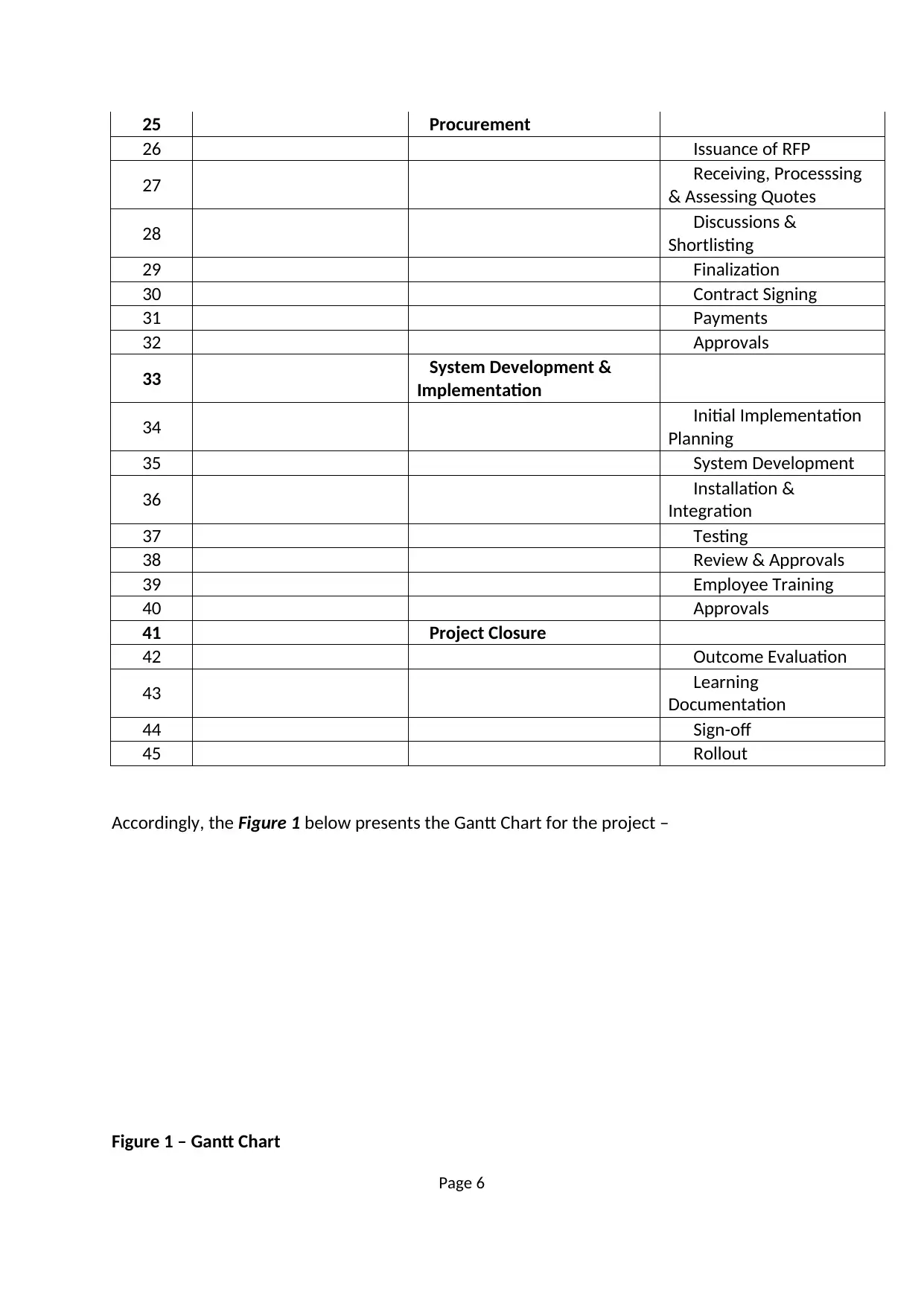
25 Procurement
26 Issuance of RFP
27 Receiving, Processsing
& Assessing Quotes
28 Discussions &
Shortlisting
29 Finalization
30 Contract Signing
31 Payments
32 Approvals
33 System Development &
Implementation
34 Initial Implementation
Planning
35 System Development
36 Installation &
Integration
37 Testing
38 Review & Approvals
39 Employee Training
40 Approvals
41 Project Closure
42 Outcome Evaluation
43 Learning
Documentation
44 Sign-off
45 Rollout
Accordingly, the Figure 1 below presents the Gantt Chart for the project –
Figure 1 – Gantt Chart
Page 6
26 Issuance of RFP
27 Receiving, Processsing
& Assessing Quotes
28 Discussions &
Shortlisting
29 Finalization
30 Contract Signing
31 Payments
32 Approvals
33 System Development &
Implementation
34 Initial Implementation
Planning
35 System Development
36 Installation &
Integration
37 Testing
38 Review & Approvals
39 Employee Training
40 Approvals
41 Project Closure
42 Outcome Evaluation
43 Learning
Documentation
44 Sign-off
45 Rollout
Accordingly, the Figure 1 below presents the Gantt Chart for the project –
Figure 1 – Gantt Chart
Page 6
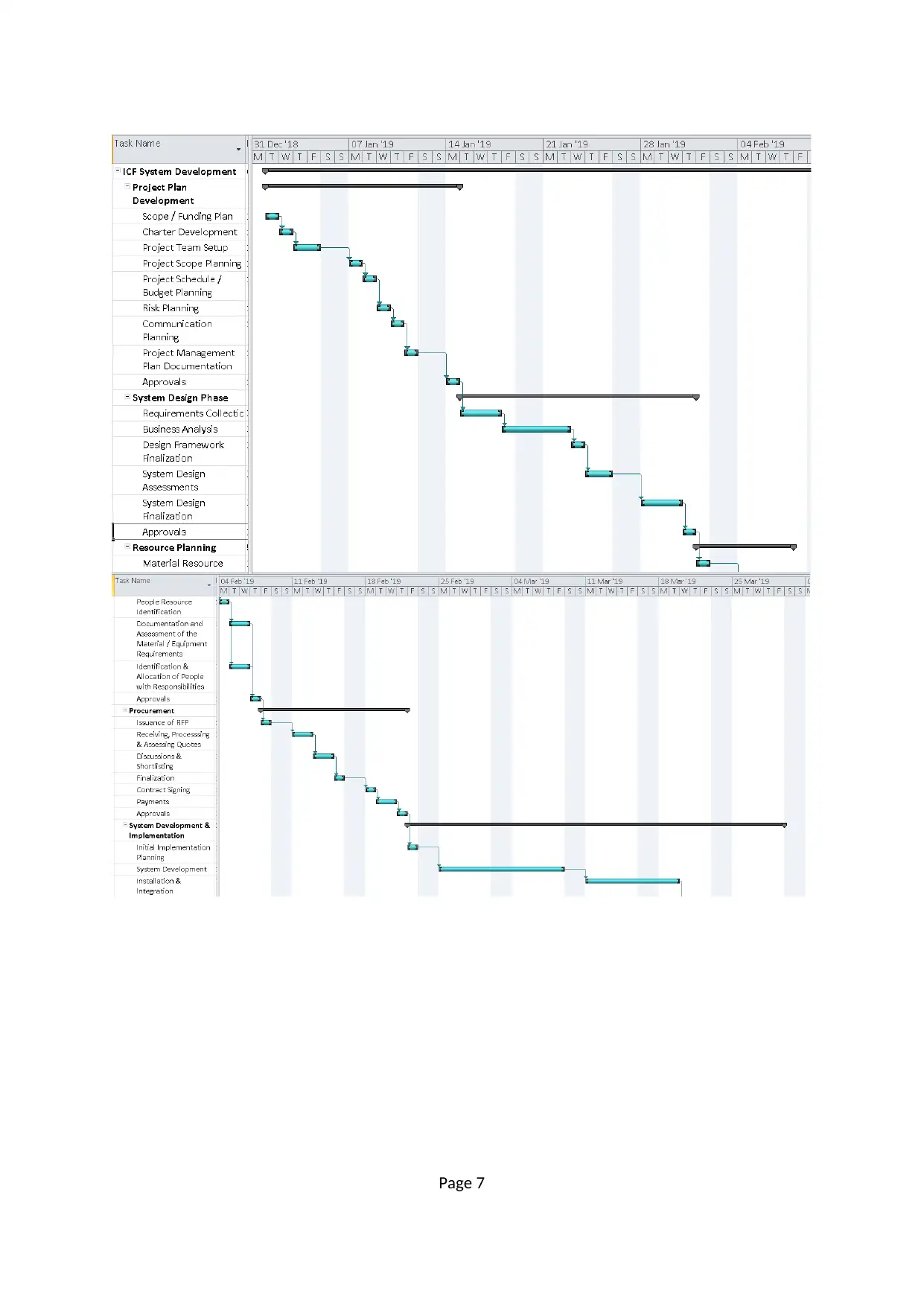
Page 7
⊘ This is a preview!⊘
Do you want full access?
Subscribe today to unlock all pages.

Trusted by 1+ million students worldwide

The key basis for the development of the schedule for this project stems from the following
factors [i] the waterfall approach adopted, [ii] the need to complete the project in 3 months,
and [iii] the various requirements, outcomes, and organization specific contexts of the
system development.
Page 8
factors [i] the waterfall approach adopted, [ii] the need to complete the project in 3 months,
and [iii] the various requirements, outcomes, and organization specific contexts of the
system development.
Page 8
Paraphrase This Document
Need a fresh take? Get an instant paraphrase of this document with our AI Paraphraser
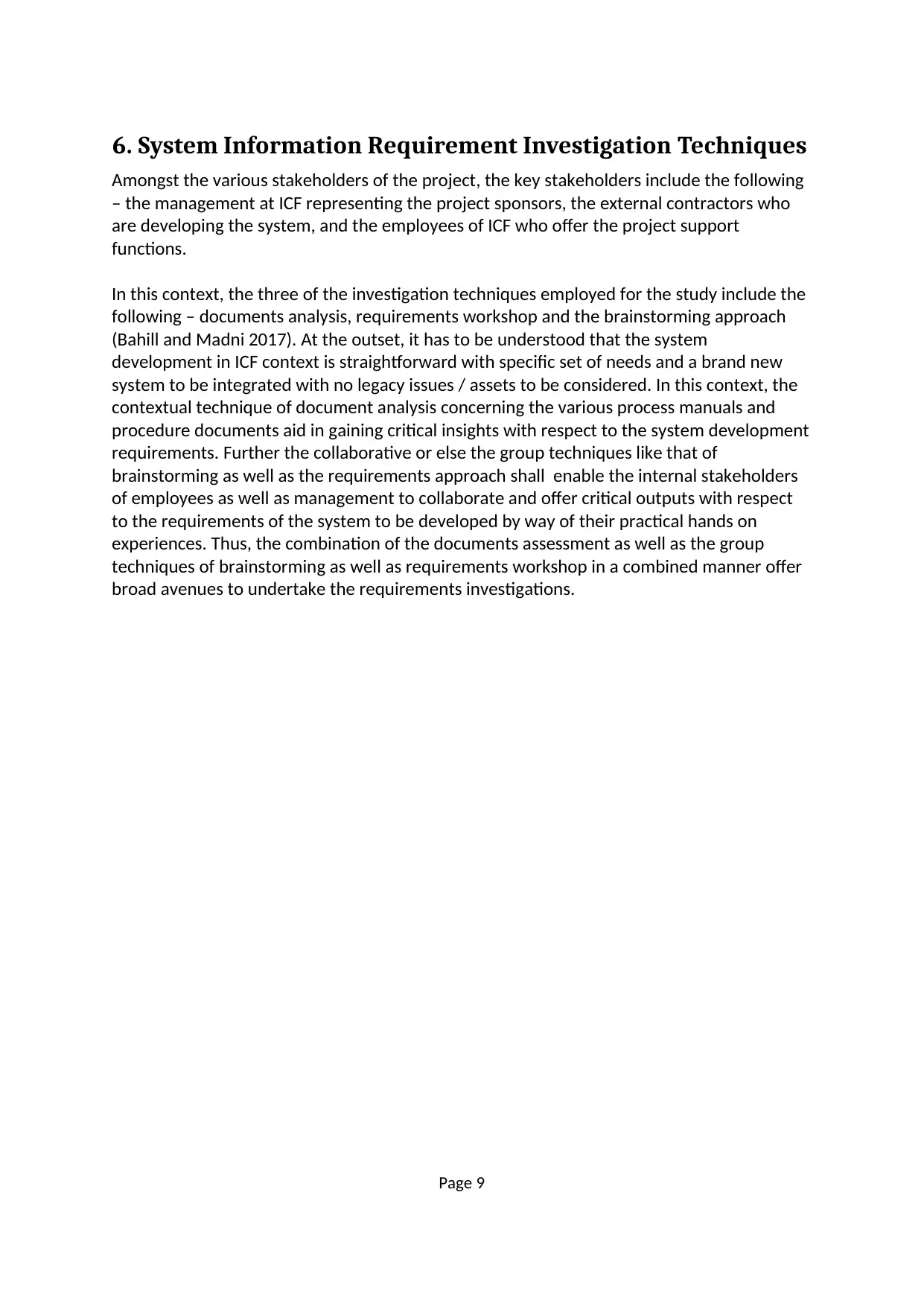
6. System Information Requirement Investigation Techniques
Amongst the various stakeholders of the project, the key stakeholders include the following
– the management at ICF representing the project sponsors, the external contractors who
are developing the system, and the employees of ICF who offer the project support
functions.
In this context, the three of the investigation techniques employed for the study include the
following – documents analysis, requirements workshop and the brainstorming approach
(Bahill and Madni 2017). At the outset, it has to be understood that the system
development in ICF context is straightforward with specific set of needs and a brand new
system to be integrated with no legacy issues / assets to be considered. In this context, the
contextual technique of document analysis concerning the various process manuals and
procedure documents aid in gaining critical insights with respect to the system development
requirements. Further the collaborative or else the group techniques like that of
brainstorming as well as the requirements approach shall enable the internal stakeholders
of employees as well as management to collaborate and offer critical outputs with respect
to the requirements of the system to be developed by way of their practical hands on
experiences. Thus, the combination of the documents assessment as well as the group
techniques of brainstorming as well as requirements workshop in a combined manner offer
broad avenues to undertake the requirements investigations.
Page 9
Amongst the various stakeholders of the project, the key stakeholders include the following
– the management at ICF representing the project sponsors, the external contractors who
are developing the system, and the employees of ICF who offer the project support
functions.
In this context, the three of the investigation techniques employed for the study include the
following – documents analysis, requirements workshop and the brainstorming approach
(Bahill and Madni 2017). At the outset, it has to be understood that the system
development in ICF context is straightforward with specific set of needs and a brand new
system to be integrated with no legacy issues / assets to be considered. In this context, the
contextual technique of document analysis concerning the various process manuals and
procedure documents aid in gaining critical insights with respect to the system development
requirements. Further the collaborative or else the group techniques like that of
brainstorming as well as the requirements approach shall enable the internal stakeholders
of employees as well as management to collaborate and offer critical outputs with respect
to the requirements of the system to be developed by way of their practical hands on
experiences. Thus, the combination of the documents assessment as well as the group
techniques of brainstorming as well as requirements workshop in a combined manner offer
broad avenues to undertake the requirements investigations.
Page 9
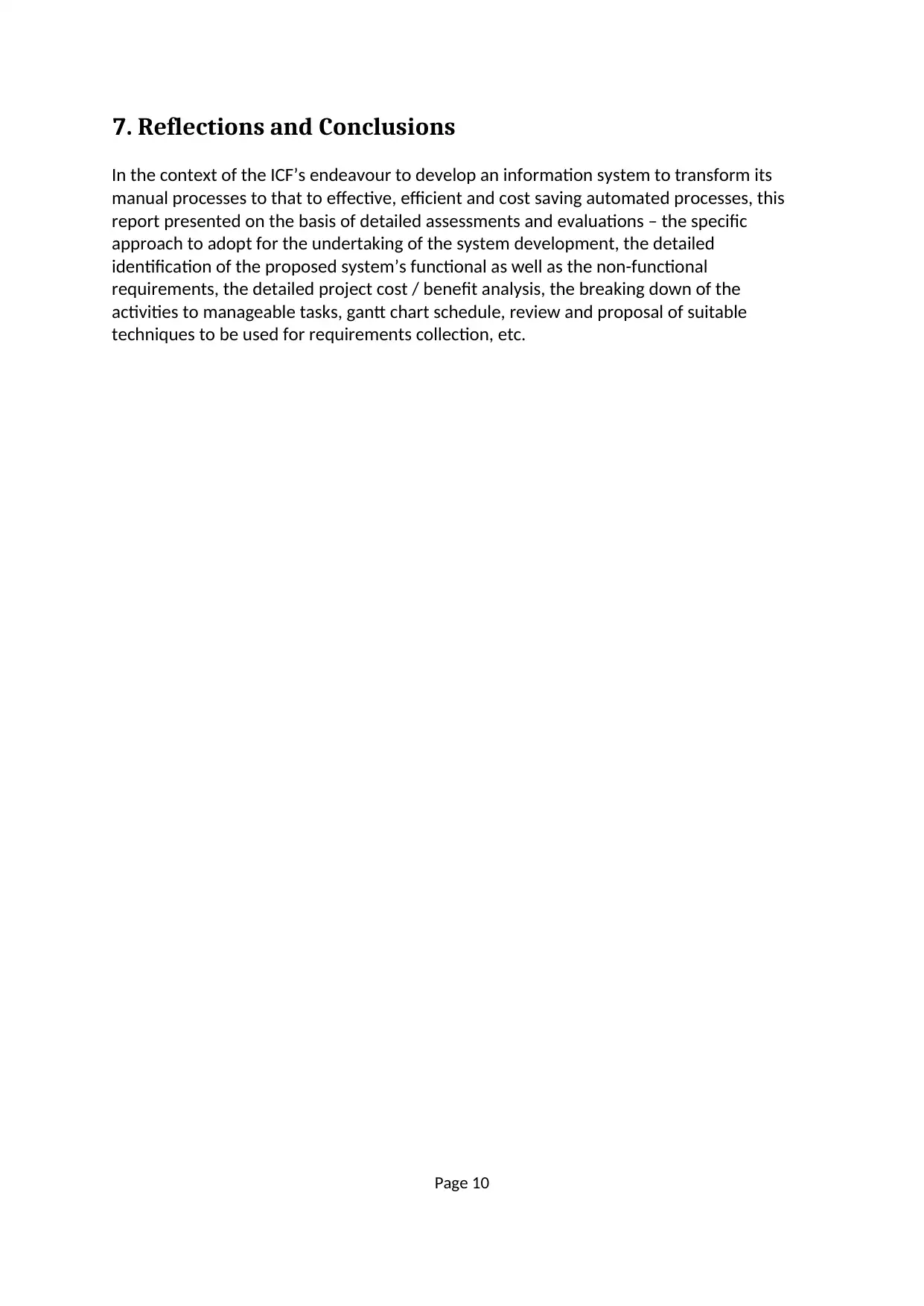
7. Reflections and Conclusions
In the context of the ICF’s endeavour to develop an information system to transform its
manual processes to that to effective, efficient and cost saving automated processes, this
report presented on the basis of detailed assessments and evaluations – the specific
approach to adopt for the undertaking of the system development, the detailed
identification of the proposed system’s functional as well as the non-functional
requirements, the detailed project cost / benefit analysis, the breaking down of the
activities to manageable tasks, gantt chart schedule, review and proposal of suitable
techniques to be used for requirements collection, etc.
Page 10
In the context of the ICF’s endeavour to develop an information system to transform its
manual processes to that to effective, efficient and cost saving automated processes, this
report presented on the basis of detailed assessments and evaluations – the specific
approach to adopt for the undertaking of the system development, the detailed
identification of the proposed system’s functional as well as the non-functional
requirements, the detailed project cost / benefit analysis, the breaking down of the
activities to manageable tasks, gantt chart schedule, review and proposal of suitable
techniques to be used for requirements collection, etc.
Page 10
⊘ This is a preview!⊘
Do you want full access?
Subscribe today to unlock all pages.

Trusted by 1+ million students worldwide
1 out of 13
Related Documents
Your All-in-One AI-Powered Toolkit for Academic Success.
+13062052269
info@desklib.com
Available 24*7 on WhatsApp / Email
![[object Object]](/_next/static/media/star-bottom.7253800d.svg)
Unlock your academic potential
Copyright © 2020–2025 A2Z Services. All Rights Reserved. Developed and managed by ZUCOL.




